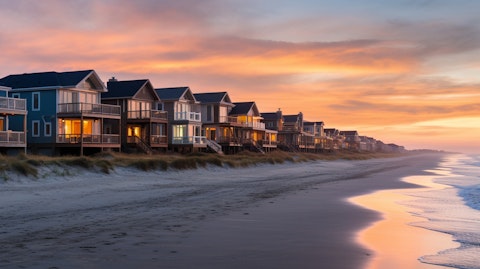Vacasa, Inc. (NASDAQ:VCSA) Q3 2023 Earnings Call Transcript November 7, 2023
Vacasa, Inc. misses on earnings expectations. Reported EPS is $-18.37443 EPS, expectations were $0.98.
Operator: Thank you for standing by. My name is Greg, and I will be your conference operator today. At this time, I would like to welcome everyone to the Vacasa Third Quarter 2023 Earnings Conference Call. All lines have been placed to prevent any background noise. [Operator Instructions] Thank you so much. I would like to now turn the call over to Jay Gincco [ph], Vice President, Investor Relations. And with that, Jay, you have the floor.
Unidentified Company Representative: Good afternoon, everyone, and thank you for joining us today for Vacasa’s third quarter 2023 earnings call. I’m pleased to be joined today by CEO, Rob Greyber; and CFO, Bruce Schuman. Before we begin, let me cover a few administrative details. This call contains information that speaks only as of today’s date. We have posted a shareholder letter on the Investor Relations section of our website at investors.vacasa.com that will be referenced by our speakers. Comments made during this conference call and in our shareholder letter contain forward-looking statements. Such statements include those about future expectations, beliefs, plans, projections, strategies, targets, estimates, objectives, events, conditions and financial performance, including guidance for future period results, which are based on what the company believes is reliable as of today’s date.
We caution you that various factors could cause actual results to differ materially from those anticipated. For additional information concerning these risks and uncertainties, please read the forward-looking statements section in the shareholder letter we issued earlier today and the forward-looking Statements and Risk Factors section in our filings with the Securities and Exchange Commission. During this call, we will focus primarily on various non-GAAP financial measures. Information regarding our non-GAAP financial results including a reconciliation of non-GAAP results to the most directly comparable GAAP financial measures may be found in our shareholder letter. These non-GAAP measures should be considered in addition to our GAAP results and are not intended to be a substitute for our GAAP results.
And now I would like to hand the call over to Rob Greyber. Rob?
Rob Greyber: Good afternoon, everyone, and thank you for joining us. I’m pleased to be with you all today to share the progress the business has made during the third quarter and to review our financials and outlook. We wrapped up the third quarter, Vacasa’s seasonally strongest, facilitating over 500,000 reservations with the majority of those taking place in July and August, the second two months of our three-month peak season. That’s over 0.5 million family trips, weekend getaways, overdue breaks and highly anticipated summer vacations. For our team, for our industry, bringing vacations home means creating moments for family and friends, moments that happen at kitchen counters or around coffee tables and over board games, and in that way, moments that are unique to the vacation rentals category and so important to our homeowners and guests.
We are still navigating a dynamic macroeconomic and industry environment. Demand for our category in leisure markets looks different today than during the highs of 2021 and 2022. And while reservation volume remains robust, many homeowners across the industry are now making less from their homes than in those prior years. While these dynamics have challenged our business in recent periods, notably in revenue and homeowner retention, we remain highly focused on delivering for our homeowners and guests. And once again, we generated millions in income for our homeowners during the third quarter. I remain extremely optimistic about Vacasa’s potential and continue to believe we are, by far, the best option for homeowners who want to participate in the vacation rental industry.
Our scale also uniquely positions Vacasa to develop technology-driven products that result in a truly differentiated experience for our homeowners and our guests. We are working better and more efficiently in all our functions, and you can see that in our results. We believe in the vast majority of our markets based on our data, Vacasa listings are generating more revenue than the industry. Last November, when I spoke with you all for the first time, I outlined 4 critical priorities I wanted to tackle during my first year at Vacasa. These were: improving execution in local markets and customer support functions, unlocking the potential of the individual sales approach, developing the right technology products and service offerings and ruthlessly prioritizing our business needs to drive profitable execution.
Let me be clear, there is more to do and will get done. But as we look back over the past 12 months, we have made significant progress against each priority. I’m proud of how our local teams performed across our markets during our third and busiest quarter. They delivered outstanding hospitality experiences to our guests, while also leveraging some of our latest technology tools to increase efficiency. For example, earlier this year, we told you about new capabilities in the automated scheduling systems used by our field operations teams. These capabilities help our team or manage daily tasks, including ensuring homes are in top condition ready to welcome guests. These features are particularly helpful during peak season when home utilization is high, and there may only be a small window between guest stays and it’s imperative that we have a well-planned schedule for our local teams.
These systems help our local teams get to our homes at the right time with the right work planned, ready to be completed on time, and it’s working. During the third quarter, we achieved a higher property condition score every single week compared to last year based on guest feedback while operating in a more efficient manner. In the spring, we also refined a number of internal processes around housekeeping, including sharing post clean photos from our clean inspection tool with owners. This had two important benefits. First, our clean scores from guests have been higher year-over-year in the third quarter. Second, homeowner see real-time images of their home after every inspection that gives them the peace of mind that their home is being taken care of and we received positive homeowner feedback on this feature.
It’s just another touch point that keeps them connected to their home and allows them to see the work our field teams do. The positive results from our automated scheduling tool and enhanced inspection process are important proof points that our investment in differentiated technology is paying dividends. It’s driving efficiency in our operations and more importantly, its resulting in a better experience for homeowners and guests. Over time, these products will only get better with 500,000 reservations, you have 500,000 new opportunities to identify areas of improvement. Our individual sales approach, the primary way in which we add homes to our platform, had another quarter of improving productivity year-over-year and another quarter of developing and building on the local market presence and expertise that attracts our prospective homeowners.

We continue to refine the way we attract homeowners shifting more of our resources to local channels and initiatives. This supports our locally based sales and operating teams, allowing them to participate in community events, and lets us sponsor unique local activities. We had a blast at last annual Falmouth Road festival on the Massachusetts Coast and the Gulf Chan Festival in Panama City Beach, Florida. We’re also giving potential homeowners more reasons to choose Vacasa over our local peers. For example, Vacasa was selected as a launch partner for the new offering from American Express Travel select homes and retreats, a channel that positions us to reach more premium travelers. Our scale and commitment to quality positions us to provide these types of opportunities for our homeowners to reach more travelers across an expanding channel mix.
With all that said, the short-term rental industry continues to adjust to a dynamic macroeconomic environment and changing travel patterns, and we see the impacts of this in elevated levels of homeowner churn. Homeowners are responding to recent market conditions, evaluating if they should continue to rent out their home, and if so, on what terms. We remain keenly focused on continuing to proactively communicate with homeowners, optimizing the rental income and delivering exceptional hospitality to guests. Our product and technology teams continue to focus on building products that deliver a one-two punch, making Vacasa’s operations more efficient and improving the experience for our homeowners and guests. We do this by feature enhancements to existing products as well as by focusing our efforts on larger scale products that have this double benefit.
These include the improved photo inspection tool and automated scheduling tool I just mentioned, which would generate measurable cost efficiencies and positive owner feedback. We are also rigorously evaluating and taking steps to improve our internal technology infrastructure. Examples include adding additional filtering criteria to vacasa.com to help guests find the perfect home, making it easier for guests to provide feedback on their stay and in the field, simplifying the way they transact with owners and vendors. Finally, we continue to prioritize driving efficiency across our business. We are carefully managing our operating expenses with technology development, sales and marketing and general and administrative expenses down year-over-year.
We are also being judicious about the homes we manage on our platform, seeking to ensure all homes are the right fit across a variety of criteria, including homeowner objectives, rental income potential, the location of homes within a market and revenue potential for Vacasa. We will continue to regularly assess the quality fit and mix of our inventory at homes. In closing, we remain focused on making improvements across our business, from the way we manage local operations to ruthlessly prioritizing our technology and product resources to the highest ROI. There is more to do. But I believe as you look back over the past 12 months, you’ll see we have made substantial progress. I want to take a moment to thank all our Vacasa team members across the country across all functions, who are each playing an important role in continuing to improve our product offering and furthering our lead as the top vacation rental management platform in North America.
Now I’ll turn the call over to Bruce to discuss our third quarter results and provide an updated outlook. Bruce?
Bruce Schuman: Thanks, Rob. First, I’ll review our third quarter financial results, then I’ll provide an updated outlook. Unless noted otherwise, I will be comparing our third quarter results to the third quarter of 2022, and I’ll be referencing the operating expense lines, excluding the impact of stock-based compensation, restructuring costs and business combination costs, which you can find outlined in our shareholder letter. For the third quarter, gross booking value, which is the combination of nights sold and gross booking value per night sold, was $830 million, down 14% year-over-year. Night sold were $2 million in the third quarter, down 1% year-over-year. And gross booking value per night sold was $406 in the third quarter, down 14% year-over-year.
Night sold per home on our platform was roughly flat year-over-year. We’ve discussed the decline in average gross booking value per home year-over-year as the industry continues to come off of the record highs from the past few years, and we saw this trend continue in the third quarter. Remember also, there is a strong relationship between night sold and gross booking value per night sold, and it’s difficult to look at either in isolation. Our revenue management algorithms and data team constantly evaluate the trade-off between price and occupancy and the mix of night sold and gross booking value per night sold with the goal of optimizing homeowner income. Revenue, which consists primarily of our commission on the rents we generate for homeowners, the fees we collect from guests and revenue from home care solutions provided directly to our homeowners was $379 million in the third quarter, down 8% year-over-year.
Now turning to our expenses. Cost of revenue was 40% of revenue in the third quarter versus 42% of revenue in the same period last year. Operations and support expense was 17% of revenue in the third quarter versus 18% of revenue in the same period last year. These 2 expense lines primarily consist of our local market and customer support costs. Our third quarter results are the strongest example yet of the progress we are making in operating our local markets in a more efficient manner. We decreased cost of revenue by 13% year-over-year and operations and support expense by 15% year-over-year, while supporting roughly the same number of homes and nights sold and delivering better guest satisfaction results. We are also demonstrating operating discipline in our central operations where we achieved year-over-year leverage across our 3 other operating expense lines in the third quarter.
Specifically, on a year-over-year basis, technology and development expense was down 11%, sales and marketing expense declined 23% and general and administrative expenses declined 33%. Adjusted EBITDA was $74 million for the third quarter compared to $46 million in the same period last year. Now turning to the outlook. With peak season now complete, we are raising our outlook for full year 2023. Based on current business trends and conditions, we now expect 2023 revenue to decline by 7% to 6% year-over-year. We also expect adjusted EBITDA of between $5 million and $15 million. At the midpoints of our guidance, this implies expected 2023 revenue about $75 million lower than last year, but adjusted EBITDA about $35 million higher compared to last year.
While there is more to do, I believe our improved outlook for 2023 speaks to the progress the team is making in advancing our operating discipline against a dynamic industry backdrop. That said, while it’s early, as we look ahead to 2024, we believe many of the trends we are seeing in the back half of this year, specifically the normalization of traveler demand for domestic nonurban vacation rentals from the highs of 2021 and 2022, which impacts our revenue and homeowner retention will likely continue. We remain focused on improving our execution and driving targeted initiatives to support further efficiency gains throughout our business, all while adapting to the changing environment. We will provide you with more color during our fourth quarter and full year 2023 financial results call.
With that, Rob and I will take your questions. Operator, please open up the lines.
See also 12 Best Performing Dividend Stocks in 2023 and 11 Best November Dividend Stocks To Buy.
Q&A Session
Follow Vacasa Inc.
Follow Vacasa Inc.
Operator: [Operator Instructions] And our first question today looks like it comes from the line of Jed Kelly with Oppenheimer. Jed, go ahead.
Jed Kelly : Great. Thanks for taking my question. Two, if I may. Once again, you’re getting a lot of efficiencies on a lower revenue base. So can you just talk about where that’s coming from? How sustainable that is heading into next year? And then following up on the commentary you just gave for ’24, you said the trends are likely to continue. I think industry RevPAR is probably down around 13% this year. So do you think per unit RevPAR can start to grow in the back half? And then just on the churn comment, do you think you’re losing homes to other property managers? Or is this more of a function of the homeowners doing it themselves? Thank you.
Bruce Schuman: Yes, Jed, this is Bruce. I think the first one, I’ll touch on your — kind of what’s driving the EBITDA improvement, the efficiency improvements. Really, this is primarily as a function of our kind of the focus we’ve had on the local market operations efficiency year-over-year, kind of the central ops efficiencies we’ve driven year-over-year. We’re just really laser-focused on those, and that’s really what’s driving kind of this year-over-year improvement in EBITDA. I think your question on ’24, as we think about how that plays into next year. I think we’re focused on — it’s early in the booking cycle, first of all, kind of bookings on the folks for ’24. It’s very early. But as you look ahead, while we’re still in the early planning phase.
As we think about some of the trend in the second half of ’23, things like the declining homeowner income, some of the churn dynamics we’ve seen, we think those likely could continue. So we’re focused on improving that as we — we’re also seeing some changing booking patterns like for Q4, except for length of stay is coming in a bit lower. So we’re really keeping an eye on that and how that evolves. So it’s pretty early to provide further color there. We’re just focused on taking care of the needs of our owners and guests and really continuing to operate the business more efficiently and drive savings. And if you look at what we delivered in Q3, I think that’s kind of the best results, example of what we can drive that in that area.
Jed Kelly : Thank you. And then just on a follow-up. You did mention some of your technology progress, I think, last week or a couple of weeks ago was the largest industry event. I mean, there was a pretty full vendor haul. So can you just talk about sort of where you’re winning on the technology front versus, say, the smaller property manager that can take a third-party technology and sort of do distribution and do rate management as well? Thanks.
Rob Greyber: Yes. Jed, this is Rob. Good to talk with you. I think, first of all, I think there’s a couple of different dimensions where we see advantage, and we continue to invest behind it. So first, when it comes to how we think about revenue management, there are a number of different tools out there. We look very closely how those different platforms are performing versus what we’re able to drive in the market and for our owners. And we think that we’re performing very favorably against those other platforms and how those teams are deploying them. And that should be intuitive, right? There are — there’s powerful technologies out there, but we have the biggest platform. We can see how dynamics evolve across the largest spectrum of markets.
And we also have the ability to control that technology and to tune it over time. So we think that the market bears that out. Now we’re obviously — we want to do that for every owner in it — for every home in every market, and we work to try to make that as true as possible. But I think when you zoom back, I think that the cost has executed well there, and we’re going to continue to invest to keep that advantage over the long term. I think there’s also a number of great technology platforms that are out there in the market. But again, it comes down to what type of integrated experience can those operators deliver if they’re having to try to knit together these various scenes versus what we’re able to drive and what we’re starting to really drive to optimize now.
The home visit optimization is one example of that. In a peak season, you don’t just need to be able to get a booking and then to try to turn a clean that helps the maintenance during a very busy season. And being able to get the right teams with the right work scheduled and the right pieces in place to be able to take care of the home and then turn it quickly. Those are the things that a more integrated platform can provide. And those are some of the — those are two examples of where I think that we have that advantage. So those are the areas where we’re focused. We think you see the impact of them in the numbers that we deliver. All of that is against the tough industry backdrop. But we think that, that’s going to be a source of advantage for us in the long term and in lots of different economic seasons.
Operator: And our next question comes from the line of Doug Anmuth with JPMorgan. Doug, go ahead.
Dae Lee: This is Dae for Doug. Thanks for taking the questions. So the first one on the homeowner churn. When I think last quarter, you guys had talked about it being elevated at stable. Just wondering given your comment this quarter, if there’s some changes that you’re seeing in the amount of churn? And then secondly, your comments about some of the current trends continuing to 2024. I guess as we look out, is this the case that normalization is still kind of happening and that you expect it to get a little bit worse before it improves? Or is this just more of — things are stable now just to that the, I guess, lower base that you guys could grow off of? Do you want to get any clarification around that? Thank you.
Rob Greyber: Yes. Let me start, and then I’ll hand it over to Bruce to sort of add some thoughts. So onshore, as we called out, we’ve begun to see some higher levels of churn as we move through the fourth quarter last year. I think that coincided with changes in the slowing of booking growth, some changes in the demand environment. And we began to see owners citing homeowner revenue as a reason for churn as they were frustrated by bookings coming off of the record high the industry had experienced in 2021, in 2022. So we’ve been continuing to kind of take the steps to set those expectations to listen to what they want to see play out in the marketplace and do our best to manifest that and make it happen against an industry backdrop that I think is continuing to translate into lower rental income in 2023.



